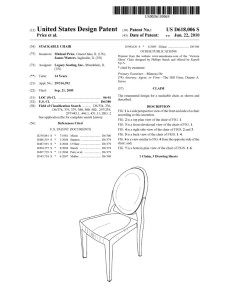We have an interesting “employed to invent” story which arose in what I suspect can be the most common of situations—two people invent a product, form a company to commercialize it, file a patent application, and then have a falling out before the patent application is even completed. Who owns the patent?
In Legacy Seating, Inc. v. Commercial Plastics Co., Michael Price and James Watters collaborated on creating the “Mirage Chair,” shown at right. Who actually invented it is a bit fuzzy; the application originally listed Watters as the sole inventor, after their falling out it was later changed to Price alone, and it finally listed the two as co-inventors.
The design work was done in April and May 2008 and on May 29, 2008 the two men formed plaintiff Legacy Seating, Inc., with Price owning 50% and Watters’ wife owning 50%. During their meetings with the lawyer who set up the corporation, Price and Watters said they intended to apply for a design patent that Legacy would own.
The relationship didn’t last long; the product wasn’t as successful as they expected. Price said he terminated Watters in July 2009 and bought him out in September 2009, but that Watters refused to recognize the buyout or the termination.
Meanwhile we have the pending patent application. As you would expect, Watters refused to assign the patent application to Legacy. After the patent issued, Legacy brought a patent infringement suit against Commercial Plastics Co. (CPC), the company that had originally be manufacturing on behalf of Legacy but was now (presumably) selling the chairs without making any payment to Legacy on the sales.
One cannot bring a patent infringement claim unless all co-owners are joined. CPC pointed out that while Price had assigned his patent rights to Legacy, Watters had not. Legacy therefore had to show that it owned Watters’ rights in the patent, even though he refused to sign the assignment. The theory by which this is done is “employed to invent.”
When one is “employed to invent,” there is an implied-in-fact contract to assign patent rights, allowing the employer to become the “owner of that property which is developed and of any invention incident to it.”
Here, the court took a two-step approach—since the invention was before Price and Watters incorporated Legacy Seating, was there a partnership that pre-existed Legacy Seating and, if so, was Watters an employee of it?
Yes to the first; the joint work of Price and Watters and their later formation of Legacy Seating showed that, more probably than not, there was a partnership.
The rub was whether there was an “employer-employee” relationship and there was not. Under Illinois law a person cannot be an employee and a partner at the same time in the same business. The two worked jointly developing the chair and procuring the mold manufacturer and production manufacturer, then Watters became a 50% owner of Legacy Seating (well, not quite, his wife was) and was President. He was therefore not an employee of the partnership, but a partner. And “Legacy cannot have it both ways—Watters may not be both a partner and an employee.”
Legacy’s attempt to use some emails to prove that Watters assigned the invention didn’t work either. When asked to review the patent application and sign the power of attorney and assignment form, Watters’ response “It looks ok” is not a manifestation of an assent to the assignment—”the common sense reading of Watters’s response is that he was indicating that the application was correct, not assenting to the assignment or power of attorney documents.”
The patent infringement claims was dismissed with leave to amend to add Watters as a plaintiff.
Legacy Seating, Inc. v. Commercial Plastics Co., No. 13 C 02777 (N.D. Ill. Aug. 20, 2014).

The text of this work is licensed under a Creative Commons Attribution-No Derivative Works 3.0 United States License.



Leave a Reply